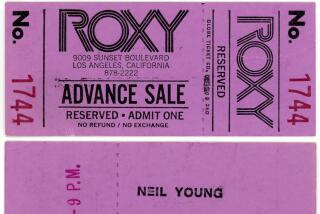BEST FOOT FORWARD?
- Share via
In general, I applaud anyone who tries to avoid cheapening the image of a film icon. It’s a little harder to applaud the person who allowed Fred Astaire to be made into a shill for vacuum cleaners (“Fred Is Her Co-Pilot,” by Irene Lacher, Aug. 17).
But what’s most shocking about Robyn Astaire is her attitude toward people who seek to use Fred Astaire’s image in the most common and respectful way: by using clips from the films that made him famous.
To refuse George Stevens Jr.’s request to use Fred Astaire’s image in a Kennedy Center tribute to Ginger Rogers is mean-spirited, but to demand $70,000, as Stevens says she did, is shocking. Most studios will license clips for well under $10,000 a minute--to ask for seven times that to show Fred Astaire’s image is outrageous.
It will be interesting to see how the judiciary interprets Astaire’s rights when her case against Best Film & Video Corp. has completed its journey through the courts. How is it that there can be such a discrepancy between Fred Astaire’s estate asking $70,000 for permission to use his image and Humphrey Bogart’s estate asking nothing? Any objective measure would rank both stars as roughly equal in “name value.”
I’m sad to say that Robyn Astaire comes off as both arrogant and greedy. Her eccentric interpretation of her rights and her willingness to demand exorbitant amounts of money to grant them is hard to condone.
RENEE LEASK
Glendale
*
All you have to do is contrast using Astaire clips to honor someone who was a big part of his career against using them for a commercial for a vacuum cleaner to see which one is detrimental to Fred’s memory and exploitative. I think Robyn Astaire needs to get her priorities straight--Fred’s memory first, money second.
SHEILA M. COOLEY
Van Nuys
*
That Fred Astaire found love and solace in the person of a very young woman during his waning years was no doubt comforting and desirable. That this same woman who “hated musicals growing up” now has artistic control over his body of work is a travesty. Her judgments, she assures us, would be shared by Astaire. I doubt it.
As for the “intellectual property” of Fred Astaire passing on to his children after Robyn’s death--who’s kidding whom? Isn’t she younger than they?
SYLVIA LEWIS
Thousand Oaks
*
“All I did,” Robyn Astaire says, “was substitute in each frame one of Fred’s props for one of Dirt Devil’s products.”
Ah, but that is not all she has done, not by a long shot. She has also deleted classic American pop melodies by Irving Berlin and Burton Lane in favor of Madison Avenue Muzak. What’s worse, she has totally destroyed the beauty and continuity of Astaire’s choreography with choppy editing and disruptive insert shots--precisely the techniques against which Astaire rebelled when he first came to Hollywood from Broadway in the early ‘30s.
To ignore Astaire’s innovative film style while claiming to honor his artistry is tantamount to honoring Satchmo without reference to his having played the trumpet.
MAUREEN C. SOLOMON
PRESTON NEAL JONES
Los Angeles
*
Tom Karsch, senior vice president for Turner Classic Movies, is saddened that “there will be a generation of people growing up who think Gene Kelly was the No. 1 dancer in Hollywood.”
It may be heretical to challenge the “He’s No. 1” accolade that was officially draped over Fred Astaire under the aegis of the Reagan regime, but there are some of us who hold the unshakable conviction that Gene Kelly was the No. 1 movie dancer.
Astaire’s gifts are unarguable, but how dare anyone patronize the man who gave us the “American in Paris” ballet? When did Astaire come even close to achieving the sensuality that Kelly brought to every non-comedic dance he ever did? (Compare the two men when each danced opposite Cyd Charisse as a femme fatale in “Singin’ in the Rain” and “The Band Wagon.”)
MARY and JOHN D.F. BLACK
Canoga Park
More to Read
Only good movies
Get the Indie Focus newsletter, Mark Olsen's weekly guide to the world of cinema.
You may occasionally receive promotional content from the Los Angeles Times.









